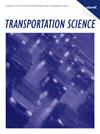An Iterated Local Search Metaheuristic for the Capacitated Demand-Driven Timetabling Problem
IF 4.8
2区 工程技术
Q1 OPERATIONS RESEARCH & MANAGEMENT SCIENCE
引用次数: 0
Abstract
In many major cities, metro lines constitute the backbone of urban public transport, providing an efficient and greener alternative to private mobility. An important feature that distinguishes metro lines from other public transport means, such as buses, is that metros are typically tightly resource constrained. The trains operating on a particular line are often specifically fitted for that line, making any capacity expansion extremely costly and time-consuming. Therefore, researchers and operators alike are seeking ways to make better use of existing resources. One possible way of doing so is by adapting timetables to forecasted demand while accounting for limited vehicle capacities. Thus, we consider a demand-driven nonperiodic timetabling problem for a two-directional metro line that minimizes the total passenger waiting time through the efficient scheduling of the available trains. Considering that passengers board trains using a well-mixed policy, we explicitly account for train capacities on a moment-to-moment basis. Last, we consider that trains are allowed to short turn. In this respect, we assume that trains must pass by a given station before short turning and are only allowed to idle after having short turned. We devise a polynomial time algorithm for assessing the total passenger waiting time generated by a given timetable and an effective lower bound that is evaluated in linear time. These are used in a variable neighborhood search algorithm, which is embedded in an iterated local search metaheuristic. Classical local search-based neighborhoods are not effective for our problem because they do not explicitly handle the vehicle scheduling decisions. To handle this challenge, we proposed three tailored neighborhoods. We validate our heuristic on the uncapacitated version of the problem. Considering a benchmark of 48 artificial instances with up to 20 stations, our heuristic achieved an average gap of 0.67% and found eight new best solutions. We also validated our heuristic on three sets of instances based on realistic lines from Milan, Madrid, and Beijing. Furthermore, we demonstrate the operational advantages of our optimized timetables in the capacitated version of the problem by comparing them with regular timetables and with exact solutions obtained for the uncapacitated case. Furthermore, we conduct a sensitivity analysis with respect to the capacity of the trains and investigate the impact of a priority boarding policy. Supplemental Material: The online appendix is available at https://doi.org/10.1287/trsc.2022.0271 .容量需求驱动时间表问题的迭代局部搜索元启发式算法
在许多大城市,地铁线路构成了城市公共交通的支柱,为私人出行提供了一种高效、环保的选择。地铁线路区别于其他公共交通工具(如公共汽车)的一个重要特征是,地铁通常受到严格的资源限制。在某条线路上运行的列车通常是专门为该线路安装的,这使得任何运力扩张都极其昂贵和耗时。因此,研究人员和运营商都在寻找更好地利用现有资源的方法。一种可能的方法是在考虑到有限的车辆容量的情况下,根据预测的需求调整时间表。因此,我们考虑了一个需求驱动的非周期地铁双向线路调度问题,该问题通过有效调度可用列车来最小化乘客总等待时间。考虑到乘客乘坐火车时使用的是混合策略,我们明确地考虑了每一刻的列车容量。最后,我们考虑允许列车短转弯。在这方面,我们假设火车必须在短转弯前通过一个给定的车站,只有在短转弯后才允许闲置。我们设计了一个多项式时间算法来评估给定时间表产生的总乘客等待时间,并在线性时间内评估有效的下界。它们被用于可变邻域搜索算法,该算法嵌入到迭代局部搜索元启发式中。经典的基于局部搜索的邻域对我们的问题并不有效,因为它们没有明确地处理车辆调度决策。为了应对这一挑战,我们提出了三个量身定制的社区。我们在问题的无能力版本上验证我们的启发式。考虑到有多达20个站点的48个人工实例的基准,我们的启发式算法实现了0.67%的平均差距,并找到了8个新的最佳解决方案。我们还基于米兰、马德里和北京的现实线路,在三组实例上验证了我们的启发式。此外,通过将优化后的时间表与常规时间表和非限制情况下的精确解进行比较,证明了优化后的时间表在有限制情况下的运行优势。此外,我们对列车容量进行了敏感性分析,并调查了优先登机政策的影响。补充材料:在线附录可在https://doi.org/10.1287/trsc.2022.0271上获得。
本文章由计算机程序翻译,如有差异,请以英文原文为准。
求助全文
约1分钟内获得全文
求助全文
来源期刊

Transportation Science
工程技术-运筹学与管理科学
CiteScore
8.30
自引率
10.90%
发文量
111
审稿时长
12 months
期刊介绍:
Transportation Science, published quarterly by INFORMS, is the flagship journal of the Transportation Science and Logistics Society of INFORMS. As the foremost scientific journal in the cross-disciplinary operational research field of transportation analysis, Transportation Science publishes high-quality original contributions and surveys on phenomena associated with all modes of transportation, present and prospective, including mainly all levels of planning, design, economic, operational, and social aspects. Transportation Science focuses primarily on fundamental theories, coupled with observational and experimental studies of transportation and logistics phenomena and processes, mathematical models, advanced methodologies and novel applications in transportation and logistics systems analysis, planning and design. The journal covers a broad range of topics that include vehicular and human traffic flow theories, models and their application to traffic operations and management, strategic, tactical, and operational planning of transportation and logistics systems; performance analysis methods and system design and optimization; theories and analysis methods for network and spatial activity interaction, equilibrium and dynamics; economics of transportation system supply and evaluation; methodologies for analysis of transportation user behavior and the demand for transportation and logistics services.
Transportation Science is international in scope, with editors from nations around the globe. The editorial board reflects the diverse interdisciplinary interests of the transportation science and logistics community, with members that hold primary affiliations in engineering (civil, industrial, and aeronautical), physics, economics, applied mathematics, and business.
 求助内容:
求助内容: 应助结果提醒方式:
应助结果提醒方式:


